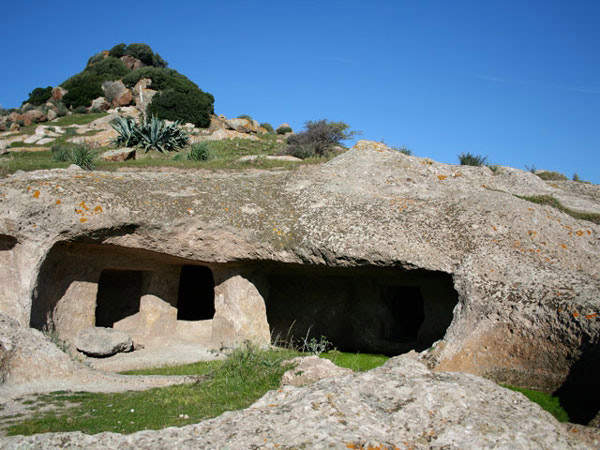

The fairy houses
This is the poetic name that translates the Sardinian word domus de janas. These artifacts are rock-cut tombs typical of Sardinian prehistoric culture. In Sardinia, about 2,400 have been found, although scholars think that there are many others yet to be discovered. The dating of the sites varies from the final phases of the Neolithic period (3,500 BC) to the end of the Bronze Age (2,800 BC). But who built these mysterious tombs? And how can we explain this very particular construction typology present only in Sardinia?

Not just nuraghi
If we talk about prehistoric Sardinia, we immediately think of nuraghiand Nuragic culture, but, on the island, the archaeological and anthropic evidence are much older. In Sardinia social, economic, spiritual and artistic manifestations called "prenuragic cultures" developed, like the so-called "culture of San Ciriaco" and "culture of Ozieri". The characteristics of the people who created these rudimentary forms of society are: predominantly agricultural vocation, production of precious ceramics, adoration of the Mother Goddess, the Sun and the Bull.

Eastern influences
The high-quality pottery found closely resembles the Cycladic and Cretan artifacts. It was therefore assumed that these Sardinian civilizations had an oriental origin or that, however, they had frequent contacts with the Aegean populations. This hypothesis is corroborated by the spirituality of the ancient Sardinians who worshiped the Mother Goddess, like so many other eastern Mediterranean cultures. The deity was depicted through steatopigic figurines (with accentuated feminine forms) as a propitiatory symbol of fertility.

Furthermore, the frequent symbolism of the taurine horns (male counterpart of the Mother Goddess) is closely linked to the Cretan culture in which the bull played a fundamental role. The animal is linked to the myth of the Minotaur or to the famous "taurocatapsia", the ritual stunt that the young Cretans performed by grasping the bull by the horns (a similar activity is practiced even today in the south of France, demonstrating a tradition strongly rooted in the Mediterranean). The symbolism of the bull is also present in the menhirs, phallic stone columns stuck in the ground, present in large numbers in Sardinia, but also in various other parts of the world. Moreover, bull protomes often welcome visitors who visit the domus de janas, probably as a sign of hope, a mitigator of the death idea.

And after death?
The cult of the dead is one of the most distinctive features of these protosarde cultures. The burials they practiced are a sign of a belief in life - or rather - regeneration after death. In many domus de janas and other prenuragic sacred monuments (such as in the megalithic altar of Monte d’Accoddi) traces of ocher red-color, symbol of fertility and life, were found.

Nomen omen
We wonder if Mr. Angelo Ruju (or in Sardinian dialect Anghelu Ruju) would have thought that his name would have become so famous. As the owner of the plot of land where the largest underground necropolis of Sardinia was found, he gave the name with which this site is universally known. Yet the case had meant that Angelo had a surname that recalled a peculiar characteristic of the domus de janas, the red color: "ruju" in Sardinian means really red!

The necropolis
The site was discovered by chance. Some human remains and furnishings were found at the beginning of the 1900s, during the construction of a farmhouse belonging to a winery still present near the archaeological site. Then, the famous archaeologist Antonio Taramelliwas called. He was born in Udine but was "Sardinian" by adoption because he carried out his greatest excavations on the island, contributing enormously to the knowledge of the prenuragic, nuragic and Phoenician-Punic civilization in Sardinia.

The scholar immediately realized that he was in front of a site of considerable dimensions: over the years, 38 domus de janas were found. Organized in several rooms (except one), the tombs have two types of entrance: a pozzetto(from top to bottom) or adromos, with an access corridor, similar to the Mycenaean tombs. The decorations symbolize the afterlife: taurine protomes, false access doors, red ocher color. Inside the sepulchral niches were found the bone remains in a supine or fetal position, as well as various objects that constituted the funeral equipment: ornamental artifacts, lithic and bronze tableware, figurines depicting the Mother Goddess. These objects have allowed us to date the site to a period ranging from 4,200 to 1,800 BC.

Necropolis of Anghelu Ruju
Address: Strada Provinciale 42 dei Due Mari, 07041 Alghero SS
Phone: 329 438 5947
Site:
https://www.necropoliangheluruju.comLocation inserted by
Caterina Kate